Eggplant (Solanum melongena L.) is a member of the family Solanaceae and is botanically related to tomato, pepper and potato. Eggplants are native to India and China but were introduced to southern Europe and the Mediterranean region by Arabic traders.
Botany
Eggplants produce a bushy, vigorous plant with large leaves, woody stems and attractive flowers. Some eggplant cultivars can reach a height of 4.5 feet. Eggplants have a deep taproot, which helps them tolerate dry weather. Flowers are open for two to three days and are self-pollinated. However, bees may improve both pollination and yield of eggplant. Fruits vary in size and shape, from round to bell-shaped, oval or elongated. Oriental or Japanese eggplant cultivars have elongated fruit. The fruit surface of eggplant is smooth and glossy. Fruit color can be yellow, green, white, purple, black, violet or various combinations of these colors (Figure 1, Table 1).
Before choosing an eggplant cultivar for commercial production, make sure there is a market demand for that particular type of eggplant. Some consumers prefer specific shapes, colors and sizes of eggplants.
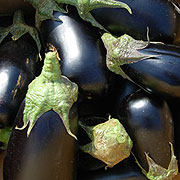
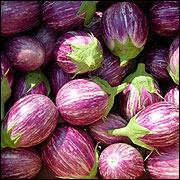
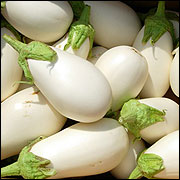
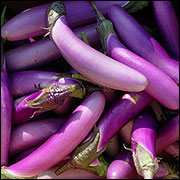
Table 1. Suggested eggplant cultivars.
| Cultivar | Fruit color | Fruit shape | Days to harvest |
|---|---|---|---|
| Calliope | White/purple | Oval | 64 |
| Casper | White | Bell-shaped | 70 |
| Classic | Purple | Elongated | 76 |
| Dusky | Purple/black | Bell-shaped | 56 |
| Epic | Purple/black | Bell-shaped | 65 |
| Fairy Tale | Purple/white stripes | Elongated | 65 |
| Ghostbuster | White | Oval-shaped | 80 |
| Ichiban | Purple | Elongated | 60 |
| Little Fingers | Purple | Elongated | 65 |
| Millionaire | Purple/black | Elongated | 55 |
| Nadia | Purple/black | Oval-shaped | 65 |
| Orient Charm | Pink/white | Elongated | 65 |
| Rosa Bianca (Italian heirloom) | Violet/white | Round | 73 |
| Santana | Purple/black | Oval-shaped | 80 |
| Tango | White | Cylindrical | 60 |
Transplant production
Eggplants are most successfully established as transplants. Start with good quality seed, and sow the seed for transplants 8 to 10 weeks before the anticipated planting date. Eggplants can suffer transplant shock, so using a larger container size (2 inches or larger) to grow the transplant will be helpful. A starter solution containing phosphorus should be applied to each newly transplanted eggplant.
Planting date
Eggplants thrive in warm, dry weather but are more sensitive to low temperature injury than tomatoes and peppers. Therefore, eggplants need to be transplanted after all risk of frost has passed. Eggplants respond favorably to being grown on plastic mulch with drip irrigation. Black plastic mulch will accelerate crop growth because it keeps the root zone warm. For later plantings, white plastic mulch can be used. In Missouri, transplanting date depends on geographical location within the state (Table 2).
Table 2. Suggested planting dates for eggplant in Missouri.
| Location | Planting dates |
|---|---|
| Northern Missouri | 5/15 to 6/15 |
| Central Missouri | 5/10 to 6/15 |
| Southern Missouri | 5/1 to 6/25 |
Planting and fertilization
Choose a well-drained soil for planting eggplants. Although eggplants are deep-rooted, they do not grow well in poorly drained soil. The soil pH should be 6.0 to 7.0 for optimum growth. Plants can be spaced 18 to 36 inches apart with rows 4 to 5 feet apart. Eggplant can also be planted in twin rows with 18 to 36 inches between plants and between rows on raised beds 3 to 4 feet apart on center.
Sixty pounds of nitrogen per acre should be applied to the soil before planting with all the recommended phosphorus and potassium applied based on a recent soil test. If the eggplants are not being grown on plastic mulch, an additional 40 to 60 pounds of nitrogen per acre can be side dressed at first flowering (three weeks after transplanting). If plastic mulch and drip irrigation are being used, 10 pounds of nitrogen per acre can be injected into the drip irrigation system per week for four weeks, starting one week after transplanting. Irrigation may be needed through the production season to supplement natural rainfall.
Staking
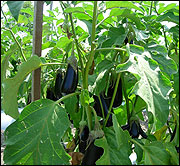
Like tomatoes and peppers, eggplants should be staked for optimum growth and yield (Figure 2). Staking keeps the eggplant fruit from touching the ground, which reduces disease and improves fruit shape, particularly on elongated fruit. Staking also makes harvesting easier. Eggplants can be staked like tomatoes, placing a wooden stake 1 inch thick and 48 to 60 inches long between every other plant in a row. String is placed along the plants and looped around each stake to support the growing stems and fruit (Figure 3).
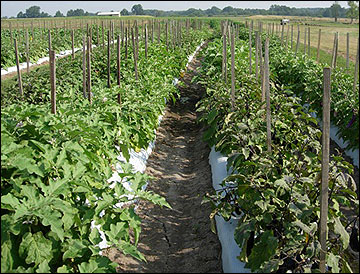
Harvest
Generally speaking, first harvest of eggplants begins 65 to 90 days from transplanting. Eggplants should be harvested when the fruit surface is glossy and tender and before seeds within the fruit become brown. Overmature fruit have a dull, bronze appearance and the seeds become bitter. Fruit should be clipped from the plant, leaving about 1 inch of stem rather than pulling the fruit from the plant. Harvest may be done two to three times a week during peak growth, depending on the fruit size desired. Failure to harvest regularly reduces flower formation and fruit yield. Eggplants can yield 500 to 700 bushels (33 pounds per bushel) per acre.
Eggplants are tender and should be handled carefully. Eggplants can be stored for up to one week at 55 degrees Fahrenheit and 90 to 95 percent relative humidity. Do not store eggplants lower than 50 degrees.
Insect management
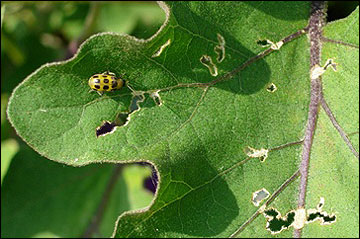
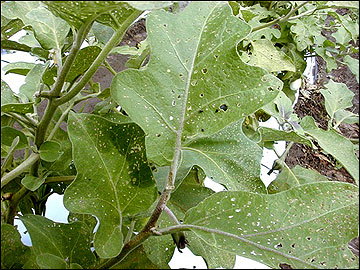
Insects are one of the most significant pests of eggplants. Cucumber beetle, Colorado potato beetle and flea beetle are particularly problematic in Missouri. Immediately after transplanting, scout plants for insect damage. Most significant damage on yield and quality of eggplant occurs from early-season damage. Flea beetles chew small holes in the leaves of eggplants but do not feed on the fruit (Figure 4). Cucumber beetles and Colorado potato beetles chew the leaves and can also damage the fruit. Rotate eggplants with vegetables botanically unrelated to eggplant. Separate eggplants from other vegetables that may attract cucumber beetles and Colorado potato beetles (e.g., potatoes and cucumbers). Row covers or lightweight insect-exclusion covers can be used to prevent these insects from feeding on the plants.